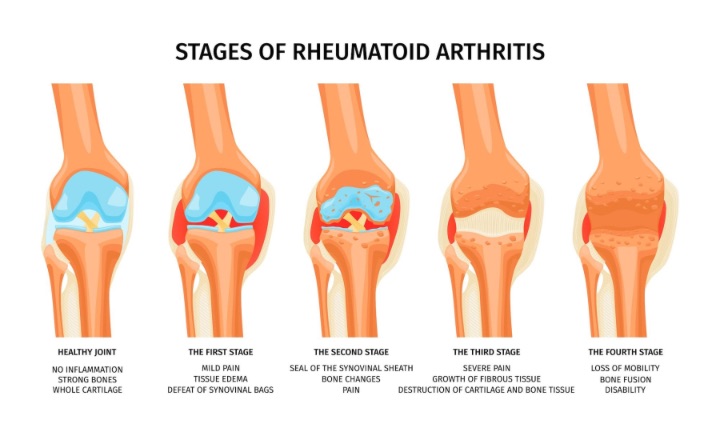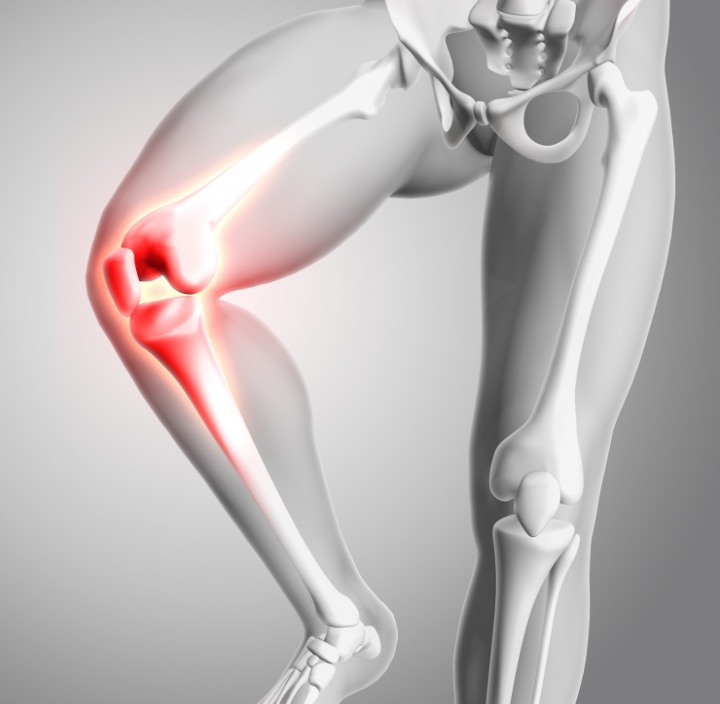Knee Arthritis is a silent yet life-altering condition. It’s an invisible enemy, that gnaws away at the quality of your life.
Arthritis of the knee, an infamous villain in orthopedic health, poses a significant threat to mobility and overall quality of life. But, what exactly does it entail? In layman’s terms, it is the wear and tear of the knee joint, resulting in pain and inflammation.
Arthritis of the knee is characterized by the degeneration of the knee joint’s cartilage. But it’s not just the cartilage at stake here. The entire joint, including bone, ligaments, and muscles, can be affected, leading to pain, stiffness, and a reduced range of motion. So how does one end up with this predicament? The answer lies in understanding the causes.
When we peek behind the curtain, various factors contribute to the onset of knee arthritis. These can broadly be categorized into age, genetics, weight, previous injuries, and certain diseases.

Photo Credit: Freepik
Unravelling each cause might illuminate ways to prevent or manage the condition.
Time and tide wait for none; unfortunately, our knees are no exception. Age is a prime factor in arthritis of the knee. As we age, the ability of our cartilage to heal decreases, leading to wear and tear over time.
Genetics plays a crucial role in predisposing individuals to this condition. If your parents or grandparents had arthritis of the knee, the odds are, you might have it too. It’s not the end of the road, though. Awareness and early intervention can work wonders.
A heavier body means more pressure on the knees, speeding up the wear and tear process. Maintaining a healthy weight can help reduce the strain on your knees and slow down the progression of arthritis.
A previous knee injury can haunt you in the form of arthritis. An injured knee is more prone to wear and tear, underscoring the importance of proper treatment and rehabilitation of any knee injuries.
Certain diseases, such as rheumatoid arthritis and psoriasis, can increase your risk of developing knee arthritis. Ensuring these conditions are well-managed can mitigate the risk.
There are several types of arthritis of the knee. Understanding these different types can help individuals better manage their symptoms and seek appropriate treatment.
Knee osteoarthritis is the most common type of arthritis of the knee, primarily older adults develop osteoarthritis. It occurs due to the gradual wear and tear of the joint over time. The protective cartilage that cushions the bones within the joint gradually breaks down, leading to pain, stiffness, and swelling which are the early symptoms of osteoarthritis. Factors such as age, genetics, obesity, previous joint injuries, and repetitive stress can sometimes lead to osteoarthritis.
Rheumatoid arthritis is an autoimmune disease that can affect multiple joints in the body, including the knee. It is a chronic inflammatory condition where the immune system mistakenly attacks the synovium, the lining of the joint.

Photo Credit: macrovector, Freepik
This results in inflammation, pain, joint stiffness, and can lead to joint deformities. It typically affects both knees simultaneously and can also cause systemic symptoms, such as fatigue and fever. Sometimes just one knee is affected by arthritis.
This type of arthritis develops as a result of a previous knee injury, such as a fracture, ligament tear, or dislocation. The initial trauma to the joint can cause damage to the articular cartilage, leading to accelerated joint degeneration over time. Symptoms of this type of arthritis may appear months or even years after the initial injury. Individuals who have experienced a knee injury, particularly athletes and those involved in high-impact activities, are at a higher risk of developing this type of arthritis.
The symptoms of knee arthritis are often subtle and develop over time. The first step in effective management is recognising these early signs.
Pain in or around the knee joint, especially during or after activity, is often the first sign of knee arthritis. If you frequently reach for a painkiller after a walk or climb, it might be time to get checked. Pain and swelling may appear together.
Knee stiffness, particularly in the morning or after periods of inactivity, is another common symptom.
Swelling or warmth around the knee joint can indicate inflammation, a key player in arthritis. The knee might appear red or feel warm to the touch.
Feeling like your knee might give way under you is a sign of knee arthritis. This symptom is due to muscle weakness and loss of proprioception or joint position sense.
Don’t despair if you recognise these symptoms. Numerous treatment options are tailored to the individual’s needs and disease severity.
Conservative management includes physical therapy, weight management, and pain medications. Physical therapy strengthens the muscles around the knee, improves flexibility, and can lead to less pain.

Photo Credit: kjpargeter, Freepik
Weight management helps by reducing the load on the knee joints. Pain medications are used to manage symptoms and improve quality of life. Sometimes doctor may even used targeted injections to help reduce pain.
When conservative measures aren’t enough, surgical intervention may be considered. This could include arthroscopy, osteotomy, or even total knee replacement surgery.
Alternative therapies like acupuncture, massage, and certain dietary supplements have shown promise in managing knee arthritis symptoms. It’s always wise to discuss these options with your healthcare provider.
Living with knee arthritis doesn’t have to be a struggle. Here are some tips and tricks to manage the symptoms and maintain a good quality of life.
Physical activity is key to managing knee arthritis. Low-impact exercises like swimming, cycling, or yoga can be beneficial.
Certain foods can help reduce inflammation and manage arthritis symptoms. Incorporate omega-3 fatty acids, antioxidants, and vitamin D in your diet.
Assistive devices like braces, canes, or walkers can help improve mobility and independence.
Maintaining a healthy weight can significantly reduce the strain on your knees.
Knee arthritis can be an unwelcome companion in the journey of life. The good news is, armed with knowledge and the right tools, you can fight back.
Understanding the causes, recognising the symptoms early, and availing appropriate treatment can significantly improve your quality of life.
Knee arthritis can’t always be prevented, especially if you have a genetic predisposition. However, there are ways to reduce your risk and delay the onset of symptoms.
Regular physical activity helps keep your joints flexible and your muscles strong. This can help reduce the pressure on your knee joint and delay the onset of arthritis.

Photo Credit: cookie_studio, Freepik
Maintaining a healthy weight can significantly reduce the stress on your knee joints. Even a small amount of weight loss can make a big difference in managing or preventing knee arthritis.
A balanced diet rich in vitamins and minerals, particularly vitamin C and D, calcium, and omega-3 fatty acids, can contribute to joint health.
Avoiding injury is essential in preventing knee arthritis. Use proper techniques when lifting and carrying, and make sure to use protective gear during sports and high-impact activities.
Listen to your body and take rest when needed. Overdoing activities when your body is telling you to rest can cause injury and exacerbate arthritis symptoms.
Regular medical check-ups can help detect early signs of knee arthritis. The earlier the diagnosis, the better the chances of effectively managing the condition.
Knee arthritis, also known as osteoarthritis of the knee, is a common type of arthritis that affects the knee joint.
Some of the risk factors for knee arthritis include aging, obesity, previous knee injuries, genetics, and repetitive stress on the knee joint.
Knee arthritis is typically diagnosed through a combination of physical examination, medical history, imaging tests such as X-rays, and sometimes joint fluid analysis.
Symptoms of knee arthritis include knee pain, stiffness, swelling, decreased range of motion, and difficulty walking or climbing stairs.
The management of knee arthritis usually involves a combination of non-surgical treatments such as pain medications, physical therapy, weight management, and assistive devices. In severe cases, knee replacement surgery may be recommended.
There are several types of knee arthritis, including osteoarthritis (most common), rheumatoid arthritis, post traumatic arthritis, and others.
Knee arthritis pain relief can be achieved through various methods such as over-the-counter or prescription pain medications, hot or cold therapy, exercise, weight management, and the use of assistive devices such as knee braces.
Currently, there is no cure for knee arthritis. However, proper management and treatment can help alleviate symptoms and improve quality of life.
Osteoarthritis is the most common knee arthritis.
Osteoarthritis in the knee can develop due to a gradual breakdown of the cartilage, which leads to joint pain and stiffness.